An Introduction to the Trinity
Finis Dake wrote the Dake Annotated Reference Bible as well as other books and materials. Many thousands of Pastors an other Christians have bought, use, and read his written materials daily. Dake frequently discussed his understanding of the Trinity in the Dake Study Bible as well as in his systematic theology God’s Plan For Man and other works. This article will show from Finis Dake’s own writings that while he used the term ‘Trinity’ he completed deviated from and changed the meaning of the word ‘Trinity’ that has been accepted by Christians for centuries and instead teaches the unbiblical and unchristian view of Tritheism. Christians of all denominations have rejected the teaching of Tritheism as unbiblical and cultic for hundreds of years. This article will show beyond a doubt that Finis Dake rejected a monotheistic God and instead embraced polytheism (many Gods). The basic understand and meaning of The Trinity is distorted and forced to mean something entirely different from what all Christian denominations and groups have always accepted the term to mean.
Why is it important that we have a biblical understanding of the Trinity? The teaching of the Trinity deals with the very nature of God. Denying the Trinity is a denial of the basic nature of who God is. Those (like Finis Dake) who worship three separate and distinct God’s are not worshiping and serving the same God as shown to us in the Bible. Finis Dake as a result taught a false god(s) and a corrupt and unbiblical view of the essential nature of God. While the Dake Bible and Dake’s “God’s Plan for Man” also deny that God is Omniscient, Omnipotent, Omnipresent, Immutable and other essential aspects of God’s essential nature, this paper will focus on his denial of the biblical understanding of the Trinity.
Finis Dake: Heretic or Biblical Teacher?
The teaching of the Trinity by the church is based on three specific and easily understood biblical teachings:
1. The Bible repeatedly tells us that there is only One God
(not three separate Gods). Some verses that there is only one God include:
Deut. 4:35; 6:4; 1 Kin. 8:60; Isa. 44:8; 45:5, 14, 22; 46:9; Dan. 3:29; Joel 2:27; Mark 2:7; 10:18; 12:29,32,33; Luke 18:19; Rom. 3:30; 1 Cor. 8:4, 6; Gal. 3:20; Eph. 4:5, 6; 1 Tim. 2:5; Jas. 2:19
This ‘Oneness’ is not just three separate god’s working together in unity (which would be tritheism and which is what Dake teaches), but means that the essence, substance, what it is that makes God, God, in singular in nature. As the Athanasian Creed says, the essence or nature of God cannot be divided into portions .
2. The Bible also teaches that there are Three in One:
- The Father is recognized as God. No debate exists here, and a number of passages teach this (John 6:27; 1 Pet. 1:2).
- Jesus Christ is recognized as God. He Himself claimed attributes that only God possesses, like omniscience (Matt. 9:4), omnipotence (28:18), omnipresence (v. 20). He did things that only God can do (and the people of His day acknowledged this, though sometimes reluctantly), like forgiving sins (Mark 2:1–12) and raising the dead (John 12:9). Further, the New Testament assigns other works that only God can perform to Christ, like upholding all things (Col. 1:17), creation (John 1:3), and future judging of all (5:27). The last phrase of John 1:1 correlates true and full deity with the Word (Christ). The phrase is best translated “the Word was God.” Consistent exegesis forbids the Jehovah’s Witnesses’ translation “the Word was a god.” The word “God” does not have an article, and if it is to be understood as indefinite (“a god”) this would be the only time in John’s Gospel that this form was used, making it highly improbable on grammatical grounds that it is indefinite here. John could not have chosen a more precise way of expressing the truths that the Word was God and yet was distinct from the Father.
- The Holy Spirit is recognized as God. He is called God (Acts 5:3–4), He possesses attributes that only God has, like omniscience (1 Cor. 2:10) and omnipresence (6:19), and He regenerates people (John 3:5–6, 8), an exclusive work of God. Ryrie, C. C. (1999).
The Athanasian Creed (written around A.D. 325).
“. . . That we worship one God in Trinity, and Trinity in Unity; Neither confounding the Persons; nor dividing the Essence. For there is one Person of the Father; another of the Son; and another of the Holy Ghost. But the Godhead of the Father, of the Son, and of the Holy Ghost, is all one; the Glory equal, the Majesty coeternal. Such as the Father is; such is the Son; and such is the Holy Ghost. The Father uncreated; the Son uncreated; and the Holy Ghost uncreated. The Father unlimited; the Son unlimited; and the Holy Ghost unlimited. The Father eternal; the Son eternal; and the Holy Ghost eternal. And yet they are not three eternals; but one eternal. As also there are not three uncreated; nor three infinites, but one uncreated; and one infinite. So likewise the Father is Almighty; the Son Almighty; and the Holy Ghost Almighty. And yet they are not three Almighties; but one Almighty. So the Father is God; the Son is God; and the Holy Ghost is God. And yet they are not three Gods; but one God. So likewise the Father is Lord; the Son Lord; and the Holy Ghost Lord. And yet not three Lords; but one Lord. For like as we are compelled by the Christian verity; to acknowledge every Person by himself to be God and Lord; So are we forbidden by the Catholic Religion; to say, There are three Gods, or three Lords. The Father is made of none; neither created, nor begotten. The Son is of the Father alone; not made, nor created; but begotten. The Holy Ghost is of the Father and of the Son; neither made, nor created, nor begotten; but proceeding. So there is one Father, not three Fathers; one Son, not three Sons; one Holy Ghost, not three Holy Ghosts. And in this Trinity none is before, or after another; none is greater, or less than another. But the whole three Persons are coeternal, and coequal. So that in all things, as aforesaid; the Unity in Trinity, and the Trinity in Unity, is to be worshipped. He therefore that will be saved, let him thus think of the Trinity.”
The Trinity is not the belief that God is three persons and only one person at the same time and in the same sense; that would be a contradiction. Rather, it is the belief that there are three persons in one nature. This may be a mystery, but it is not a contradiction. That is, it may go beyond reason’s ability to comprehend completely, but it does not go against reason’s ability to apprehend consistently. Further, the Trinity is not the belief that there are three natures in one nature or three essences in one essence. That would be a contradiction. Christians affirm that there are three persons in one essence. This is not contradictory because it makes a distinction between person and essence. To put it in terms of the law of non-contradiction, while God is one and many at the same time, he is not one and many in the same sense. He is one in the sense of his essence but many in the sense of his persons. So there is no violation of the law of non-contradiction in the doctrine of the Trinity.
A Model of the Trinity.
By saying God has one essence and three persons it is meant that he has one “What” and three “Whos.” The three Whos (persons) each share the same What (essence). So God is a unity (one) of essence with a plurality of persons. Each person is different, yet they share a common nature. God is one in his substance. The unity is in his essence (what God is), and the plurality is in God’s persons (how he relates within himself). This plurality of relationships is both internal and external. Within the Trinity each member relates to the others in certain ways. These are somewhat analogous to human relationships. The Bible’s descriptions of Yahweh as Father and Jesus as Son says something of how the Son relates to the Father. Also, the Father sends the Spirit as a Messenger, and the Spirit is a Witness of the Son (John 14:26). These descriptions help us understand the functions within the unity of the Godhead. Each is fully God, and each has his own work and interrelational theme with the other two. But it is vital to remember that the three share the same essence, so that they unify as one Being.
Some Illustrations of the Trinity. No analogy of the Trinity is perfect, but some are better than others. First, some bad illustrations should be repudiated. The Trinity is not like a chain with three links, for these are three separate and separable parts, but God is neither separated nor separable. Neither is God like the same actor playing three different parts in a play, for God is simultaneously three persons, not one person playing three successive roles. Nor is God like the three states of water: solid, liquid, and gaseous. For normally water is not in all three of these states at the same time, but God is always three persons at the same time. Unlike other bad analogies, this one does not imply tritheism, however, it does reflect another heresy known as modalism. Most erroneous illustrations of the Trinity tend to support the charge that trinitarianism is really tritheism, since they contain separable parts. The more helpful analogies retain the unity of God while they show a simultaneous plurality, and there are several that fit this description.
A Mathematical Illustration. One aspect of the problem can be expressed in mathematical terms. Critics make a point of computing the mathematical impossibility of believing there is a Father, Son and Holy Spirit in the Godhead, without holding that there are three gods. Does not 1 + 1 + 1 = 3? It certainly does if you add them, but Christians insist that the triunity of God is more like 1 x 1 x 1 = 1. God is triune, not triplex. His one essence has multiple centers of personhood. Thus, there is no more mathematical problem in conceiving the Trinity than there is in understanding 1 cubed (13).
A Geometric Illustration. Perhaps the most widely used illustration of the Trinity is the triangle. One triangle has three corners, which are inseparable from, and simultaneous to, one another. In this sense it is a good illustration of the Trinity. Of course, the triangle is finite and God is infinite, so it is not an imperfect illustration. Another aspect of the Godhead is that Christ is one person (shown as one corner of the triangle), yet he has two natures, a divine nature and a human nature. Some show this aspect graphically by symbolizing Christ’s divinity by the corner of the triangle and using another geometric figure, a circle for instance, to illustrate the human nature. At the point of the person of Jesus Christ, the circle is welded onto the triangle, human nature touching, but not mixed with, divine. Human and divine natures exist side-by-side without confusion in the Son. His two natures are conjoined in one person. Or, in Christ there are two Whats and one Who, whereas, in God there are three Whos and one What.
A Moral Illustration. Augustine suggested an illustration of how God is both three and one at the same time. The Bible informs us that “God is love” (1 John 4:16). Love involves a lover, a beloved, and a spirit of love between lover and loved. The Father might be likened to the Lover; the Son to the One loved, and the Holy Spirit is the Spirit of love. Yet love does not exist unless these three are united as one. This illustration has the advantage of being personal, since it involves love, a characteristic that flows only from persons.
An Anthropological Illustration. Since humankind is made in the image of God (Gen. 1:27), it would seem reasonable that men and women bear some snapshot of the Trinity within their being. One illustration that causes more problems than it solves is to visualize the human being as a “trichotomy” of body, soul, and spirit. Whether the trichotomist position is accurate, this is not a helpful illustration because body and soul are not an indivisible unity. They can be (and are) separated at death (cf. 2 Cor. 5:8; Phil 1:23; Rev. 6:9). The nature and persons of the Trinity cannot be separated. A better illustration based in human nature is the relation between the human mind, its ideas, and the expression of these ideas in words. There is obviously a unity among all three of these without there being an identity. In this sense, they illustrate the Trinity.
The main focus of thedakebible.com and this article is to point out the false teachings of Finis Dake. Since Finis Dake teaches Tritheism, our focus in this article will be in pointing out the many, many times that Dake denies that God is one in essence and nature. Dake teaches a ‘oneness’ only in relationship not in the essence of God. As a result Dake teaches Tritheism or the believe in three completely separate god(s). If you would like to read information that discusses all aspects of the Trinity, click the link below and choose an article to read. We do not want to repeat all of the information we have written on the Trinity and instead will try to focus specifically on Finis Dake’s corruption of the meaning, function, and essence of the Trinity in this paper.
Only One God
The first principle of the doctrine of the Trinity is that there is only one, true, eternal, living Being who is God by nature and Maker of heaven and earth. The doctrine of the Trinity is thus a rigorous form of monotheism and is absolutely hostile to polytheism in any form. Trinitarians do not believe that the Father, Son and Holy Spirit are three separate gods. Such an idea is tritheism which is a form of polytheism. Neither do Trinitarians believe that angels or men have been or will ever be God by nature. If these Trinitarian beliefs are true then what would we expect to find in the Bible?
- 1. We would expect to find in the Bible where God Himself says that He alone is God and that the gods of other religions are false gods.
- 2. We would expect to find in the Bible where prophets, priests, kings, and apostles state that there is only one God and the gods of other religions are false gods.
When we turn to the Bible, what do we find?
Only One God
God dogmatically stated on many occasions that He alone is God and that there were no other gods before Him; there are no gods besides Him now; and there will be no new ones in the future:
- “See now that I, I am He, and there is no god besides Me. It is I who put to death and give life. I have wounded, and it is I who heal; And there is no one who can deliver from My hand.” (Deut. 32:39)
- “You are My witnesses,” declares the LORD, “and My servant whom I have chosen, in order that you may know and believe Me, and understand that I am He, before Me there was no God formed, and there will be none after Me.” (Isa. 43:10)
- Thus says the LORD, the King of Israel and his Redeemer, the LORD of Hosts: “I am the first and I am the last, and there is no God besides Me.” (Isa. 44:6)
- “And you are My witnesses. Is there any God besides Me, or is there any other Rock? I know of none.” (Isa. 44:8b)
- “I am the LORD, and there is no other; besides Me there is no God.…That men may know from the rising to the setting of the sun that there is no one besides Me. I am the LORD, and there is no other…” (Isa. 45:5-6)
- “I am the LORD and there is none else.” (Isa. 45:18b)
- “Declare and set forth your case; Indeed, let them consult together. Who has announced this from of old? Who has long since declared it? Is it not I, the LORD? And there is no other God besides Me, a righteous God and a Savior; There is none except Me. Turn to Me, and be saved, all the ends of the earth; For I am God, and there is no other.” (Isa. 45:21-22)
- “Remember the former things long past, for I am God, and there is no other; I am God, and there is no one like Me.” (Isa. 46:9)
It is crystal clear from the passages above that God Himself states in unequivocal terms that there are no other gods before Him, besides Him or yet to be in the future. This is exactly what Trinitarians expected to find in the Bible. Thus, it is no surprise to find that prophets, priests, kings, and apostles taught exactly the same thing.
- “For this reason Thou art great, O Lord God; for there is none like Thee, and there is no God besides Thee.” (2 Sam. 7:22)
- “so that all the peoples of the earth may know that the LORD is God; there is no one else.” (1 Kings 8:60)
- “O LORD, there is none like Thee, neither is there any God besides Thee.” (1 Chron. 17:20)
- “Thou art the God, Thou alone, of all the kingdoms of the earth.” (Isa. 37:16)
- “Sabeans…will make supplication to you: ‘Surely, God is with you, and there is none else, no other God.’” (Isa. 45:14)
- There is none like Thee, O LORD. (Jer. 10:6)
- There is none like Thee. (Jer. 10:7)
Therefore concerning the eating of things sacrificed to idols, we know that there is no such thing as an idol in the world, and that there is no God but one. For even if there are so-called gods whether in heaven or on earth, as indeed there are many gods and many lords, yet for us there is but one God (1 Cor. 8:4-6). There is one God (1 Tim. 2:5). The evidence is so overwhelming that even the demons understand that there is only one God (James 2:19). Yet, such cults as the Mormons teach that there are actually billions of gods and that they themselves will become gods and goddesses.1
The Only True God
The God of the Bible is the one “true” God in opposition to the “false” gods of the heathen:
- “And for many days, Israel was without the true God and without a teaching priest and without law.” (2 Chron. 15:3)
- But the Lord is the true God. (Jer. 10:10)
- “that they may know Thee, the only true God.” (John 17:3)
For they themselves report about us what kind of a reception we had with you, and how you turned to God from idols to serve the living and true God (1 Thess. 1:9). This is the true God and eternal life. Little children, guard yourselves from idols (1 John 5:20, 21). These texts demonstrate that such gods as Baal, Molech, Allah, Siva, Zeus, Ra, Thor, etc., are all false gods. They are not different names for the one true God of Israel. They are false gods because they are no gods at all. They are the creations of man.
The Only Eternal God
The God of the Bible is the one true God because He alone is eternal while all the gods created by man have a beginning and will have an end. They are creatures of time and space while the true God is timeless and spaceless, i.e. infinite in all things.2 The eternity of God is taught in the Old and New Testaments in such places as Gen. 21:33; Deut. 33:27; Isa. 40:28; Jer. 10:10; Rom. 16:26; 1 Tim. 1:11.
The Only Living God
The one true God is a living Being and not a lifeless idol of wood, stone or metal. He has “life in Himself” and is thus eternally self-existent (John 5:26). He is called the “living God” many times in the Bible in contrast to the lifeless gods of the heathen:
| Deut. 5:26 | Hos. 1:10 |
| Josh. 3:10 | Matt. 16:16; 26:63 |
| 1 Sam. 17:26, 36 | Acts 14:15 |
| 2 Kings. 19:4, 16 II | 2 Cor. 3:3; 6:16 |
| Ps. 42:2; 84:2 I | 1 Thess. 1:9 |
| Isa. 37:4 I | 1 Tim. 3:15; 4:10 |
| Jer. 10:10; 23:36 | Heb. 3:12; 9:14; 10:31; 12:22 |
| Dan. 6:26 | Rev. 7:2 |
It does not really matter if we are talking about the ancient gods of the Middle East or the gods of Hinduism, Buddhism, Islam or the cults and the occult. The authors of the Bible view the gods of the heathen as lifeless as well as false.
The Only God by Nature
The apostle Paul reminded the Galatians of their pagan background: However at that time, when you did not know God, you were slaves to those [gods] which by nature are no gods. (Gal. 4:8) Ἀλλὰ τότε μὲν οὐκ εἰδότες θεὸν ἐδουλεύσατε τοῖς φύσει μὴ οὖσιν θεοῖς. Paul states that all the while they were pagans, μὲν οὐκ εἰδότες θεὸν (they did not know God)3 Lenski comments:
The condition of the Gentile Christians before their conversion…is described by the constative participle, “not knowing God.”…It is a simple fact, the Gentiles did not even know the true God; they lived in utter pagan darkness and blindness.4
He goes on to say:
All of the paganism found in the world today presents the same picture of the vilest and the most pitiful slavery. The pagan gods are not gods in any true sense of the word.5
This is the same point which Paul made to the Romans and the Corinthians (Rom. 1:18-25 and 1 Cor. 1:18-24). Secondly, Paul pointed out that the pagan gods they worshipped were “by nature no gods.” The significance of these words is paramount. When Paul wrote τοῖς φύσει μὴ οὖσιν θεοῖς·, he meant that while there are many different competing concepts of God, the Biblical God is the only true God and all the other gods are by their very nature not God. The word φύσει is the singular feminine of φύσις which means the essential nature of things in and of themselves. It refers to what things are in their nature as opposed to mere appearance.6 If the gods of the heathen are not God by nature, then what is their nature? The famous German commentator Heinrich Meyer comments:
For, in the apostle’s view, the realities which were worshipped by the heathen as gods, were not gods, but demons. In his view, therefore, their nature was not divine but at the same time not of mere mundane matter; it is demonic, a point which must have been well known to the Galatians from his oral instruction.7
In 1 Corinthians 10:20-21, Paul warned the Corinthians not to participate in pagan sacrifices because: …the things which the Gentiles sacrifice, they sacrifice to demons, and not to God; and I do not want you to become sharers in demons. You cannot drink the cup of the Lord and the cup of demons; you cannot partake of the table of the Lord and the table of demons. ἀλλʼ ὅτι ἃ θύουσιν, δαιμονίοις καὶ οὐ θεῷ [θύουσιν]: οὐ θέλω δὲ ὐμᾶς κοινωνοὺς τῶν δαιμονίων γίνεσθαι. οὐ δύνασθε ποτήριον κυρίου πίνειν καὶ ποτήριον δαιμονίων, οὐ δύνασθε τραπέζης κυρίου μετέχειν καὶ τραπέζης δαιμονίων. When Paul warned them not to sit at the τραπέζης δαιμονίων (table of demons), sipping from the ποτήριον δαιμονίων (cup of demons), while they enjoyed the κοινωνοὺς τῶν δαιμονίων (fellowship of demons), he was paraphrasing Moses who warned Israel in his day: They sacrificed to demons who were not God, to gods whom they have not known, new gods who came lately, whom your fathers did not dread. (Deut. 32:17). יִזְבְּחוּ לַשֵּׁדִים לֹא אֱלֹהַ אֱלֹהִים לֹא יְדָעוּם חֲדָשִִים מִקָּרֹב בָּאוּ לֹא שְׂעָרוּם אֲבֹתֵיכֶם׃ Moses did not hestitate to say that the heathen are יִזְבְּחוּ לשֵּׁדִּים (worshipping demons) and לֹא אֱלֹהַ (not God).
While the authors of the Bible viewed pagan idols as nothing but wood, stone and metal, at the same time, they clearly believed that the unseen powers which lay behind these gods were demonic and evil (1 Chron. 16:26; Ps. 96:5; 2 Kings 19:18; Isa. 37:19; 2 Chron. 13:9; Isa. 40:8-20, 25, 26; 45:18; Jer. 2:11; 5:7; 10:8-10; 16:20; Hab. 2:18-20; Acts 19:26; 1 Cor. 8:4-5; 10:20; Gal. 4:8). This means that all the gods of the heathen are demonic in origin and power. It really does not matter if it is Buddha, Allah, Siva, Krishna, the gods of the Mormons, the Jehovah’s Witnesses or the New Agers. They are all demon gods and any worship given to them ascends to the demons and not to God.
Many people today naively assume that all gods of all religions are equally “true” because they are all actually false. “God” is whatever you want he, she, it or them to be. Thus, no one should claim to worship the one true God. The authors of the Bible knew nothing of the sirenic ecumenicism of our day. They believed that there was the only one true God and that all the other religions and their gods were not only demonic, but stupid and foolish. While such language is not politically correct, it is thoroughly Biblical:
For among all the wise men of the nations, and in all their kingdoms, there is none like Thee. But they are altogether stupid and foolish in their discipline of delusion—their idol is wood! Beaten silver is brought from Tarshish, and gold from Uphaz, the work of a craftsman and of the hands of a goldsmith; violet and purple are their clothing; they are all the work of skilled men. But the LORD is the true God.…Every man is stupid, devoid of knowledge. Every goldsmith is put to shame by his idols; for his molten images are deceitful, and there is no breath in them. (Jer. 10:7-10, 14)
Obviously, the authors of the Bible would not have won any ecumenical awards! The apostle Paul viewed all other religions as the idolatrous result of man’s running from God:
For even when though they knew God, they did not honor Him as God, or give thanks; but they became futile in their speculations, and their foolish heart was darkened. Professing themselves to be wise, they became fools, and exchanged the glory of the incorruptible God for an image in the form of corruptible man and of birds and four-footed animals and crawling creatures. (Rom. 1:21-23)
This is tough-minded, monotheism at its best. Anything less is not biblical monotheism.
Maker of Heaven and Earth
One constant theme given throughout the Bible is that the God of Israel is the only true God because He is the Creator of all things:
- “Thou art the God, Thou alone, of all the kingdoms of the earth. Thou hast made heaven and earth. “(Isa. 37:16)
- “I, the LORD, am the maker of all things, stretching out the heavens by Myself, and spreading out the earth all alone, causing the omens of boasters to fail, making fools out of diviners, causing wise men to draw back, and turning their knowledge into foolishness. (Isa. 44:24-25)
For thus says the LORD, who created the heavens (He is God who formed the earth and made it),…I am the LORD, and there is none else.”(Isa. 45:18). The prophet Jeremiah beautifully put everything together when he said,
But the LORD is the true God; He is the living God and the everlasting King.…Thus you shall say to them, “The gods that did not make the heavens and the earth shall perish from the earth and from under the heavens.” It is He who made the earth by His power…For the Maker of all is He, and Israel is the tribe of His inheritance; The LORD of hosts is His name. (Jer. 10:10-12, 16)
The importance of God as Maker of heaven and earth cannot be under emphasized. This is why the theory of evolution is the main weapon in the atheist’s arsenal. If evolution is true, then the God of the Bible is false. It is either one way or the other.
Process Philosophy
Another modern denial of creation is found in Process philosophy and theology. Process thought defines “God” as a chance-driven, bi-polar, evolutionary process with no self-existent or continuing Being. They claim that everything, including God, is in the process of “becoming” what no one knows, not even God. They deny that God has or is a continuing “being.” Instead, God is only a “happening” or a “becoming” in a moment of eternal time. According to Process thought, God and the world are in an eternal bipolar relationship in which each needs the other. Thus, the Bible is in error when it says, “In the beginning God created the heavens and the earth” (Gen. 1:1). They turn the text around and say, “In the end the heavens and the earth shall create God.” Its denial of God as the Maker of heaven and earth is more than sufficient to reveal the pagan nature of process thought. Alfred North Whitehead, the founder of Process philosophy, openly admitted that he was resurrecting the philosophies of Heraclitus and Plato. He merely dressed them up with modern terminology. He stated that he preferred Plato and the gods of ancient Greece to the Bible and its God. He went so far as to say that the Jehovah of the Bible was his idea of the devil!8
False Dichotomies
Philosophically speaking, Whitehead and his followers assume the basic Greek philosophic dichotomy between “process” and “being” as an a priori truth. This dichotomy first appeared when the philosophies of Heraclitus (all is process) and Parmenides (all is being) clashed during the pre-Socratic period of Greece. It has never dawned on them that they may have assumed a false dichotomy to begin with. A “being” in action is what we call “process.” Thus, we do not have to choose between either being or process, as if the two concepts were mutually exclusive. We can have them both. Also, in order for process to occur, there must be some thing that is in motion because motion is not a thing. Both motion and process are qualities or attributes of a thing, i.e., being and not things in and of themselves. See our book Battle of The Gods for more details on the fundamental errors in Process philosophy and theology.
Conclusion
What must be in order for what is to be what it is? When we opened the Bible we found that it does in fact teach the first principle of the doctrine of the Trinity: There is only one, true, eternal, living Being who is God by nature and Maker of heaven and earth. This concept is exactly what we expect to find in the Bible if the doctrine of the Trinity is true.
References
- 1 See my discussion of Mormonism and its polytheism in Battle of the Gods (Southbridge, MA: Crowne, 1989), 29-40. It is obtainable from Truth Seekers, P. O. Box 250, Newport, PA 17074.
- 2 The book Battle of the Gods is a detailed demonstration of the timelessness of God and His perfect foreknowledge of all things and a refutation of Process Theology.
- 3 For a description of Galatian religion, see William M. Ramsay, A Historical Commentary on St. Paul’s Epistle to the Galatians (Grand Rapids: Baker, 1965), 86f.
- 4 R.C.H. Lenski, The Interpretation of St. Paul’s Epistle to the Galatians, Ephesians and Phillipians (Minneapolis: Augsburg, 1961), 208.
- 5 Ibid., 210.
- 6 The Greek lexicons are unanimous on this. See Thayer (p. 660) and Arndt and Gingrich (p. 877).
- 7 Henrich August Wilhelm Meyer, Critical and Exegetical Hand-Book to the Epistle to the Galatians (Winona Lake: Alpha, 1979), 178.
- 8 See Battle of The Gods, 95-100, for a full discussion of Process Philosophy and Theology.
- Morey, R. A. (1996). The Trinity : Evidence and Issues (63). Iowa Falls, IA.: World Pub.
Comphrehensive Quotes From The Dake Bible and ‘God’s Plan for Man’
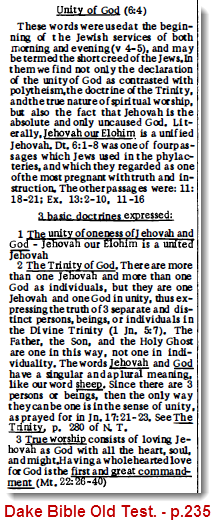
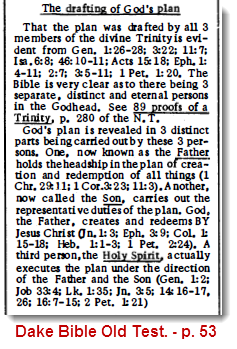
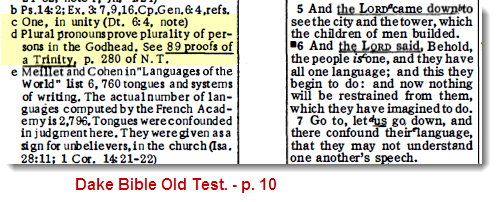
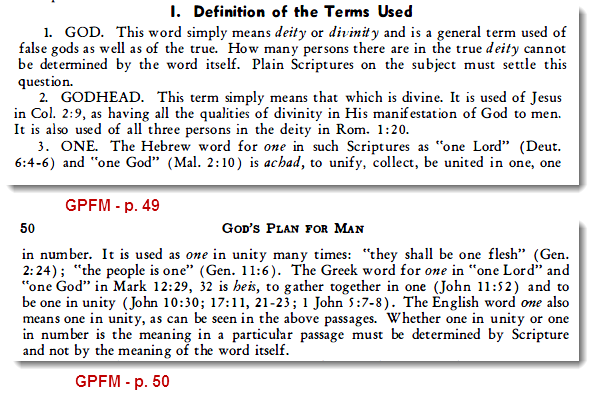
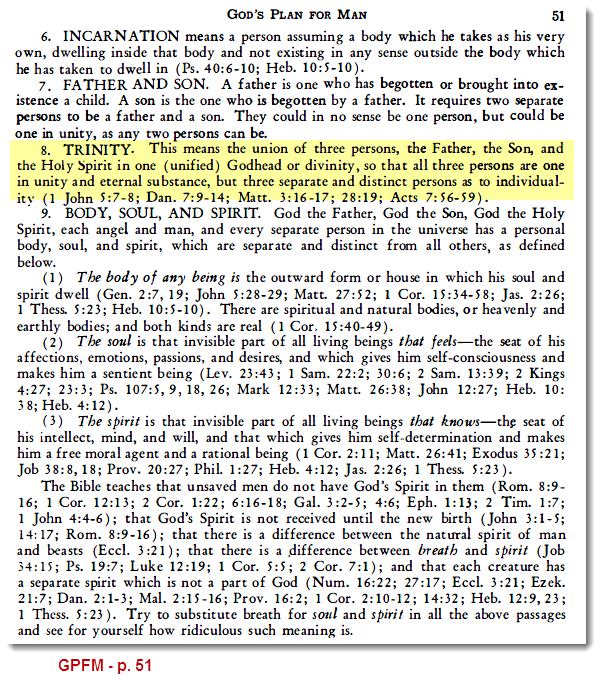
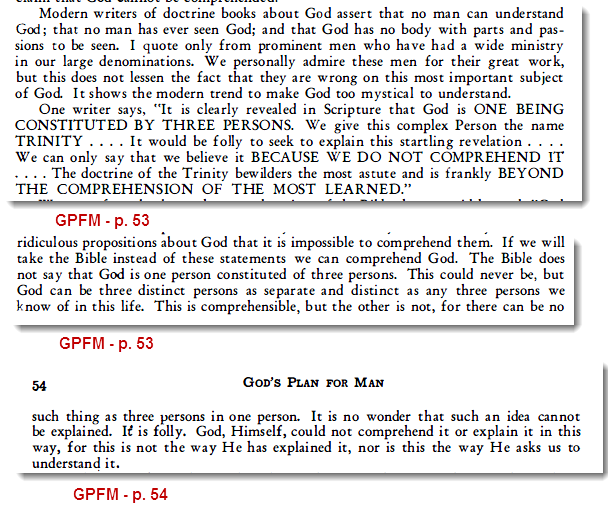
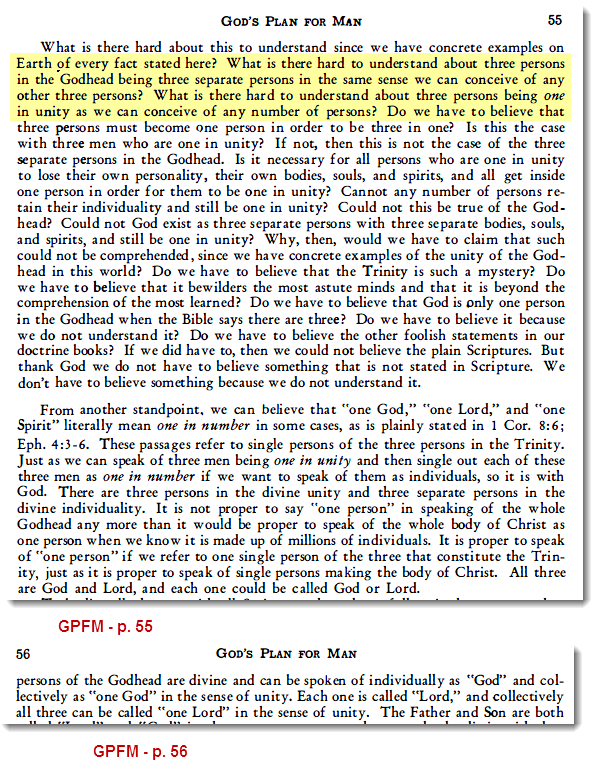
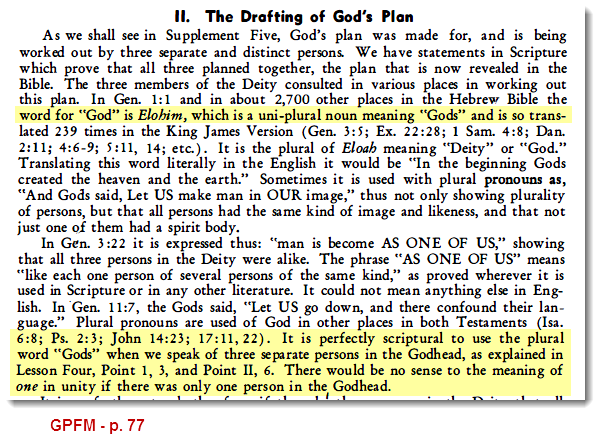
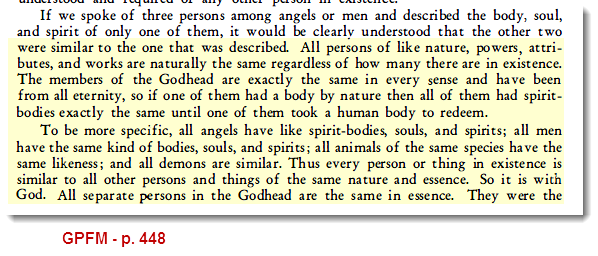
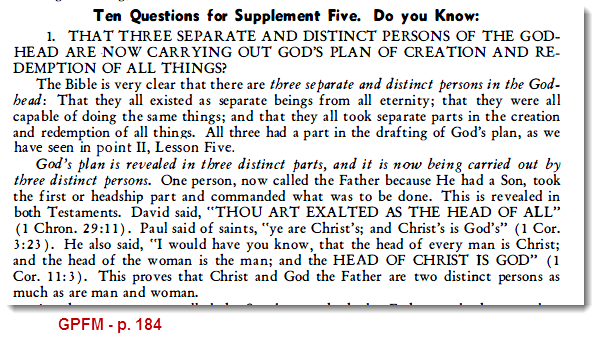
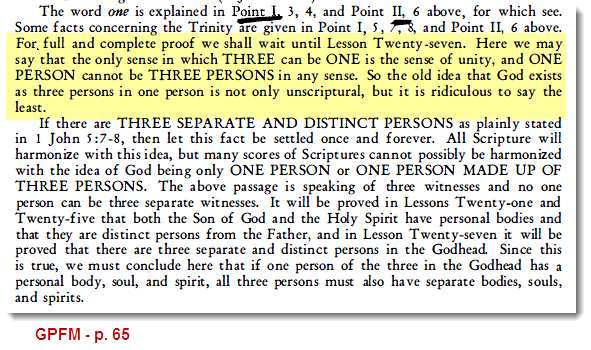

© 2025, DakeBible.org. All rights reserved.

